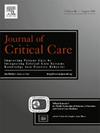Systematic review and meta-analysis of the treatment of hypernatremia in adult hospitalized patients: impact on mortality, morbidity, and treatment-related side effects
IF 3.2
3区 医学
Q2 CRITICAL CARE MEDICINE
引用次数: 0
Abstract
Background
Hypernatremia is relatively common in acutely ill patients and associated with mortality. Guidelines recommend a slow rate of correction (≤ 0.5 mmol/L per hour). However, a faster correction rate may be safe and improve outcomes.
Objectives
To evaluate the impact of sodium correction rates on mortality and hospital length of stay and to assess types of hypernatremia treatment and treatment side effects.
Methods
We conducted a systematic review and meta-analysis according to PRISMA guidelines, searching Ovid MEDLINE, Embase, and CENTRAL databases from inception to August 2024. Studies reporting sodium correction rates and clinical outcomes in hospitalized adults were included. A random-effects meta-analysis assessed mortality and hospital length of stay, with subgroup analyses exploring correction timing and severity. Treatment method and side effects were analyzed qualitatively.
Results
We reviewed 4445 articles and included 12 studies. Faster correction rates (> 0.5 mmol/L/h) overall showed no significant change in mortality and a high level of heterogeneity (OR 0.68, 95 % CI: 0.38–1.24, I2 = 95 %). However, subgroup analyses found significantly lower mortality with faster correction of hypernatremia at the time of hospital admission (OR 0.48, 95 % CI: 0.35–0.68, I2 = 2 %), with fast correction within the first 24 h of diagnosis (OR 0.48, 95 % CI: 0.31–0.73, I2 = 65 %), and for severe hypernatremia (OR 0.55, 95 % CI: 0.33–0.92, I2 = 79 %). There was no significant different in hospital length of stay by correction rate. No major neurological complications were reported when the correction rate was < 1 mmol/L/h.
Conclusion
Faster sodium correction appears safe and may benefit patients with severe admission-related hypernatremia, particularly within the first 24 h. Further studies are needed to refine correction protocols.

求助全文
约1分钟内获得全文
求助全文
来源期刊

Journal of critical care
医学-危重病医学
CiteScore
8.60
自引率
2.70%
发文量
237
审稿时长
23 days
期刊介绍:
The Journal of Critical Care, the official publication of the World Federation of Societies of Intensive and Critical Care Medicine (WFSICCM), is a leading international, peer-reviewed journal providing original research, review articles, tutorials, and invited articles for physicians and allied health professionals involved in treating the critically ill. The Journal aims to improve patient care by furthering understanding of health systems research and its integration into clinical practice.
The Journal will include articles which discuss:
All aspects of health services research in critical care
System based practice in anesthesiology, perioperative and critical care medicine
The interface between anesthesiology, critical care medicine and pain
Integrating intraoperative management in preparation for postoperative critical care management and recovery
Optimizing patient management, i.e., exploring the interface between evidence-based principles or clinical insight into management and care of complex patients
The team approach in the OR and ICU
System-based research
Medical ethics
Technology in medicine
Seminars discussing current, state of the art, and sometimes controversial topics in anesthesiology, critical care medicine, and professional education
Residency Education.
 求助内容:
求助内容: 应助结果提醒方式:
应助结果提醒方式:


